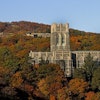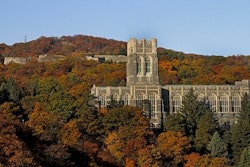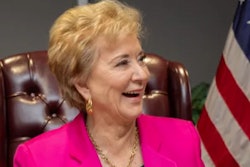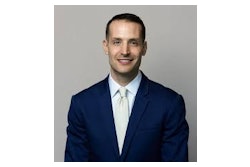College presidents from about 100 of the nation’s best-known universities, including Duke, Dartmouth and Ohio State, are calling on lawmakers to consider lowering the drinking age from 21 to 18, saying current laws actually encourage dangerous binge drinking on campus.
The movement called the Amethyst Initiative began quietly recruiting presidents more than a year ago to provoke national debate about the drinking age.
“This is a law that is routinely evaded,” said Dr. John McCardell, former president of Middlebury College in Vermont who started the organization. “It is a law that the people at whom it is directed believe is unjust and unfair and discriminatory.”
Other prominent schools in the group include Syracuse, Tufts, Colgate, Kenyon and Morehouse.
But even before the presidents begin the public phase of their efforts, which may include publishing newspaper ads in the coming weeks, they are already facing sharp criticism.
Mothers Against Drunk Driving says lowering the drinking age would lead to more fatal car crashes. It accuses the presidents of misrepresenting science and looking for an easy way out of an inconvenient problem. MADD officials are even urging parents to think carefully about the safety of colleges whose presidents have signed on.
“It’s very clear the 21-year-old drinking age will not be enforced at those campuses,” said Laura Dean-Mooney, national president of MADD.
Both sides agree alcohol abuse by college students is a huge problem.
Research has found more than 40 percent of college students reported at least one symptom of alcohol abuse or dependence. One study has estimated more than 500,000 full-time students at four-year colleges suffer injuries each year related in some way to drinking, and about 1,700 die in such accidents.
A recent Associated Press analysis of federal records found that 157 college-age people, 18 to 23, drank themselves to death from 1999 through 2005.
Moana Jagasia, a Duke University sophomore from Singapore, where the drinking age is lower, said reducing the age in the U.S. could be helpful.
“There isn’t that much difference in maturity between 21 and 18,” she said. “If the age is younger, you’re getting exposed to it at a younger age, and you don’t freak out when you get to campus.”
McCardell’s group takes its name from ancient Greece, where the purple gemstone amethyst was widely believed to ward off drunkenness if used in drinking vessels and jewelry. He said college students will drink no matter what, but do so more dangerously when it’s illegal.
The statement the presidents have signed avoids calling explicitly for a younger drinking age. Rather, it seeks “an informed and dispassionate debate” over the issue and the federal highway law that made 21 the de facto national drinking age by denying money to any state that bucks the trend.
But the statement makes clear the signers think the current law isn’t working, citing a “culture of dangerous, clandestine binge-drinking,” and noting that while adults under 21 can vote and enlist in the military, they “are told they are not mature enough to have a beer.” Furthermore, “by choosing to use fake IDs, students make ethical compromises that erode respect for the law.”
“I’m not sure where the dialogue will lead, but it’s an important topic to American families and it deserves a straightforward dialogue,” said Dr. William Troutt, president of Rhodes College in Memphis, Tenn., who has signed the statement.
But some other college administrators sharply disagree that lowering the drinking age would help. University of Miami President Donna Shalala, who served as secretary of health and human services under President Clinton, declined to sign.
“I remember college campuses when we had 18-year-old drinking ages, and I honestly believe we’ve made some progress,” Shalala said in a telephone interview. “To just shift it back down to the high schools makes no sense at all.”
McCardell claims that his experiences as a president and a parent, as well as a historian studying Prohibition, have persuaded him the drinking age isn’t working.
But critics say McCardell has badly misrepresented the research by suggesting that the decision to raise the drinking age from 18 to 21 may not have saved lives.
In fact, MADD CEO Chuck Hurley said, nearly all peer-reviewed studies looking at the change showed raising the drinking age reduced drunk-driving deaths. A survey of research from the U.S. and other countries by the Centers for Disease Control and others reached the same conclusion.
McCardell cites the work of Dr. Alexander Wagenaar, a University of Florida epidemiologist and expert on how changes in the drinking age affect safety. But Wagenaar himself sides with MADD in the debate.
The college presidents “see a problem of drinking on college campuses, and they don’t want to deal with it,” Wagenaar said in a telephone interview. “It’s really unfortunate, but the science is very clear.”
Another scholar who has extensively researched college binge-drinking also criticized the presidents’ initiative.
“I understand why colleges are doing it, because it splits their students, and they like to treat them all alike rather than having to card some of them. It’s a nuisance to them,” said Dr. Henry Wechsler of the Harvard School of Public Health.
But, “I wish these college presidents sat around and tried to work out ways to deal with the problem on their campus rather than try to eliminate the problem by defining it out of existence,” he said.
Duke faced accusations of ignoring the heavy drinking that formed the backdrop of 2006 rape allegations against three lacrosse players. The rape allegations proved to be a hoax, but the alcohol-fueled party was never disputed.
Duke senior Wey Ruepten said university officials should accept the reality that students are going to drink and give them the responsibility that comes with alcohol.
“If you treat students like children, they’re going to act like children,” he said.
Duke President Richard Brodhead declined an interview request. But he wrote in a statement on the Amethyst Initiative’s Web site that the 21-year-old drinking age “pushes drinking into hiding, heightening its risks.” It also prevents school officials “from addressing drinking with students as an issue of responsible choice.”
Hurley, of MADD, has a different take on the presidents.
“They’re waving the white flag,” he said.
Click here to post and read comments
© Copyright 2005 by DiverseEducation.com


















